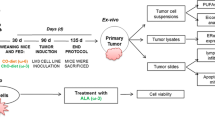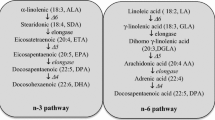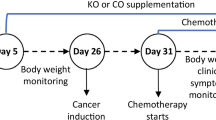Abstract
In the present study, we investigated the effects of high levels of dietary fish oil on the growth of MX-1 human mammary carcinoma and its response to mitomycin C (MC) treatment in athymic mice. We found that high levels of dietary fish oil (20% menhaden oil+5% corn oil, w/w) compared to a control diet (5% corn oil, w/w) not only lowered the tumor growth rate, but also increased the tumor response to MC treatment. We also found that high levels of dietary fish oil significantly increased the activities of tumor xanthine oxidase and DT-diaphorase, which are proposed to be involved in the bioreductive activation of MC. Since menhaden oil is highly unsaturated, its intake caused a significant increase in the degree of fatty acid unsaturation in tumor membrane phospholipids. This alteration in tumor membrane phospholipids made the tumor more susceptible to oxidative stress, as indicated by the increased levels of both endogenous lipid peroxidation and protein oxidation after feeding the host animals the menhaden oil diet. In addition, the tumor antioxidant enzyme activities, catalase (CAT), superoxide dismutase (SOD), glutathione peroxidase (GPOx), and glutathione S-transferase peroxidase (GSTPx), were all significantly enhanced by feeding a diet high in fish oil. MC treatment caused further increases in tumor lipid peroxidation and protein oxidation, as well as in the activities of CAT, SOD, GPOx, and GSTPx, suggesting that MC causes oxidative stress in this tumor model which is exacerbated by feeding a diet high in menhaden oil. Thus, feeding a diet rich in menhaden oil decreased the growth of human mammary carcinoma MX-1, increased its responsiveness to MC, and increased its susceptibility to endogenous and MC-induced oxidative stress, and increased the tumor activities of two enzymes proposed to be involved in the bioactivation of MC, that is, DT-diaphorase and xanthine oxidase. These findings support a role of these two enzymes in the bioactivating of MC and indicate that the type of dietary fat may be important in tumor response to therapy.
Similar content being viewed by others
Abbreviations
- CAT:
-
catalase
- CB5R:
-
cytochrome b5 reductase
- CCR:
-
cytochrome C reductase
- CO:
-
corn oil
- DHA:
-
docosahexaenoic acid
- DNPH:
-
3,4-dinitrophenyl hydrazine
- DTD:
-
DT-diaphorase
- EPA:
-
eicosapentaenoic acid
- GPOx:
-
glutathione peroxidase
- GR:
-
glutathione reductase
- GSH:
-
glutathione
- GSSG:
-
glutathione disulfide
- GST:
-
glutathione S-transferase
- GSTPx:
-
glutathione S-transferase peroxidase
- HNE:
-
4-hydroxy-nonenal
- MC:
-
mitomycin C
- MO:
-
menhaden oil
- PL:
-
phospholipid
- PUFAs:
-
polyunsaturated fatty acids
- SOD:
-
superoxide dismutase
- TBARS:
-
thiobarbituric reactive substances
- T/C:
-
treat/control ratio
- XD:
-
xanthine dehydrogenase
- XO:
-
xanthine oxidase
References
Welsch, C.W. (1992) Relationship Between Dietary Fat and Experimental Mammary Tumorigenesis: A Review and Critique,Cancer Res. 52, 2040s-2048s.
Carroll, K.K. (1992) Dietary Fat and Breast Cancer,Lipids 27, 793–797.
Welsch, C.W. (1987) Enhancement of Mammary Tumorigenesis by Dietary Fat: Review of Potential Mechanisms,Am. J. Clin. Nutr. 45, 192–202.
Pariza, M.W. (1988) Dietary Fat and Cancer Risk: Evidence and Research Needs,Ann. Rev. Nutr. 8, 167–183.
Gonzalez, M.J., Schemmel, R.A., Dugan, L., Jr., Gray, J.I., and Welsch, C.W. (1993) Dietary Fish Oil Inhibits Human Breast Carcinoma Growth: A Function of Increased Lipid Peroxidation,Lipids, 28, 827–832.
Kaasgaard, S.G., Holmer, G., Hoy, C-E, Behrens, W.A., and Beare-Rogers, J.L. (1992) Effects of Dietary Linseed Oil Marine Oil on Lipid Peroxidation in Monkey Liverin vivo andin vitro, Lipids 27, 740–745.
Powis, G. (1989) Free Radical Formation by Antitumor Quinones,Free Radical Biology & Medicine 6, 63–101.
Sinha, B.K. (1989) Free Radicals in Antitumor Drug Pharmacology,Chem. Biol. Interactions 69, 293–317.
Sinha, B.K., and Mimnaugh, E.G. (1990) Free Radicals and Anticancer Drug Resistance by Certain Tumors,Free Radical Biology & Medicine 8, 567–581.
Riley, R.J., and Workman, P. (1992) DT-Diaphorase and Cancer Chemotherapy,Biochem. Pharmacol. 43, 1657–1669.
Yang, C.S., Brady, J.F., and Hong, J.Y. (1992) Dietary Effects on Cytochrome P450, Xenobiotic Metabolism, and Toxicity,FASEB J. 6, 737–744.
Yoo, J-S.H., Hong, J.Y., Ning, S.M., and Yang, C.S. (1990) Roles of Dietary Corn Oil in the Regulation of Cytochrome P450 and Glutathione S-Transferase,J. Nutr. 120, 1718–1726.
Yoo, J-S.H., Ning, S.M., Pantuck, C.B., Pantuck, E.J. and Yang, C.S. (1991) Regulation of Hepatic Microsomal Cytochrome P450IIE1 Level by Dietary Lipids and Carbohydrates in Rats,J. Nutr. 121, 959–965.
Shao, Y., Pardini, L., and Pardini, R.S. (1994) Enhancement of the Antineoplastic Effect of Mitomycin C by Dietary Fat,Cancer Res. 54, 6452–6457.
American Institute of Nutrition (1977) Report of the American Institute of Nutrition Ad Hoc Committee on Standards for Nutritional Studies,J. Nutr. 107, 1340–1348.
American Institute of Nutrition (1980) Second Report of the Ad Hoc Committee on Standards for Nutritional Studies,J. Nutr. 110, 1726.
Birt, D.F., White, L.T., Choi, B., and Pelling, J.C. (1989) Dietary Fat Effects on the Initiation and Promotion of Two-Stage Skin Tumorigenesis in the SENCAR Mouse,Cancer Res. 49, 4170–4174.
Borgeson, C.E., Pardini, L., Pardini, R.S., and Reitz, R.C. (1989) Effects of Dietary Fish Oil on Human Mammary Carcinoma and on Lipid-Metabolizing Enzymes,Lipids 24, 290–295.
Ernster, L. (1967) DT-Diaphorase,Methods in Enzymology 10, 309–317.
Benson, A.M., Hunkler, M.J., and Talalay, P. (1980) Increase of NAD(P)H:Quinone Reductase by Dietary Antioxidants: Possible Role in Protection Against Carcinogenesis and Toxicity,Proc. Natl. Acad. Sci. USA. 77, 5216–5220.
Sukiman, S.A., and Stevens, J.B. (1976) Purification of Xanthine Dehydrogenase: A Rapid Procedure with High Enzyme Yield,Arch. Biochem. Biophys. 258, 2040s-2048s.
Masters, B.S.S., Williams, C.H., and Kamin, H. (1967) The Preparation and Properties of Microsomal TPNH-Cytochrome C Reductase from Pig Liver,Methods in Enzymology 10, 565–573.
Yasukochi, Y., and Masters, B.S.S. (1976) Some Properties of a Detergent Solubilized NADPH-Cytochrome C (Cytochrome P450) Reductase Purified by Biospecific Affinity Chromatography,J. Biol. Chem. 251, 5337–5344.
Oberely, L.W., and Spitz, D.R. (1984) Assay of Superoxide Dismutase in Tumor Tissue,Methods in Enzymology 105, 457–464.
Aebi, H. (1984) Catalasein vitro, Methods in Enzymology 105, 121.
Strauss, R.G., Snyder, E.L., Wallace, P.D., and Rosenburg, T.G. (1980) Oxygen Detoxification Enzymes in Neutrophils of Infants and Their Mothers,J. Lab. Clin. Med. 95, 897.
Prohaska, J.R., Oh, S-H., Hockstra, W.G., and Ganther, H.E. (1977) Glutathione Peroxidase: Inhibition by Cyanide and Release of Selenium,Biochem. Biophys. Res. Comm. 74, 64–71.
Racker, E. (1955) Glutathione Reductase,Methods in Enzymology 2, 722.
Mannervick, B., and Guthenberg, C. (1981) Glutathione Transferase: Human Placenta,Methods in Enzymology 77, 231–235.
Buege, J.A., and Aust, S.D. (1978) Microsomal Lipid Peroxidation,Methods in Enzymology LII, 302–310.
Levine, R.L., Garland, D., Oliver, C.N., Amici, A., Climent, I., Lenz, A-G., Ahn, B., Shalteil, S., and Stadtman, E.R. (1990) Determination of Carbonyl Content in Oxidatively Modified Proteins,Methods in Enzymology 77, 231–235.
Fariss, M.W., and Reed, D.J. (1987) High-Performance Liquid Chromatography if Thiols and Disulfides: Dinitrophenol Derivatives,Methods in Enzymology 143, 101–109.
Aksoy, M., Berger, M.R., and Schmahl, D. (1987) The Influence of Different Levels of Dietary Fat on the Incidence and Growth of MNU-Induced Mammary Carcinoma in Rats,Nutr. and Cancer 9, 227–235.
Gabor, H., and Abraham, S. (1986) Effect of Dietary Menhaden Oil on Tumor Cell Loss and the Accumulation of Mass of a Transplantable Mammary Adenocarcinoma in BALB/c Mice,J. Natl. Cancer Inst. 76, 1223–1229.
Hudson, E.A., Beck, S.A., and Tisdale, M.J. (1993) Kinetics of the Inhibition of Tumor Growth in Mice by Eicosapentaenoic Acid Reversed by Linoleic Acid,Biochem. Pharmac. 45, 2189–2194.
Ip, C., Carter, C.A., and Ip, M.M. (1985) Requirement of Essential Fatty Acid for Mammary Tumorigenesis in the Rat,Cancer Res., 45, 1997–2001.
Burns, A., Lin, Y-G., Gibson, R., and Jamieson, D. (1991) The Effect of a Fish Oil Enriched Diet on Oxygen Toxicity and Lipid Peroxidation in Mice,Biochem. Pharmacol. 42, 1353–1360.
Javouhey-Donzel, A., Guenot, L., Naupoil, V., Rochette, L., and Rocquelin, G. (1993) Rat Vitamin E Status and Heart Lipid Peroxidation: Effect of Dietary α-Linolenic Acid and Marine n−3 Fatty Acids,Lipids 28, 651–655.
Chen, L-C., Boissonneault, G., Hayek, M.G., and Chow, C.K. (1993) Dietary Fat Effects on Hepatic Lipid Peroxidation and Enzymes of H2O2 Metabolism and NADPH Generation,Lipids 28, 657–662.
Cho, S-H., and Choi, Y-S. (1994) Lipid Peroxidation and Antioxidant Status Is Affected by Different Vitamin E Levels When Feeding Fish Oil,Lipids 29, 47–52.
Gonzalez, M.J. (1992) Lipid Peroxidation and Tumor Growth: An Inverse Relationship,Med. Hypotheses 38, 106–110.
Spector, A.A., and Yorek, M.A. (1985) Membrane Lipid Composition and Cellular Function,J. Lipid Res. 26, 1015–1035.
Spector, A.A., and Burns, C.P. (1987) Biological and Therapeutic Potential of Membrane Lipid Modification in Tumors,Cancer Res. 47, 4529–4537.
Farber, J.L., Kyle, M.E., and Cleman, J.B. (1990) Mechanisms of Cell Injury by Activated Oxygen Species,Lab. Invest. 62, 670–679.
Roubal, W.T., and Tappel, A.L. (1966) Damage to Proteins, Enzymes, and Amino Acids by Peroxidizing Lipids,Arch. Biochem. Biophys. 113, 5–8.
Reiss, U., and Tappel, A.L. (1973) Fluorescent Product Formation and Changes in Structure of DNA Reacted with Peroxidizing Arachidonic Acid,Lipids 8, 199–202.
Dianzani, M.U. (1982) inFree Radicals, Lipid Peroxidation and Cancer (McBrien, D.C., and Slater, T.F., eds.) pp. 129–158, Academic Press, London.
Bull, A.W., Nigro, N.D., and Marnett, J.J. (1988) Structural Requirements for Stimulation of Colonic Cell Proliferation by Oxidized Fatty Acids,Cancer Res. 48, 1771–1776.
King, M.M., Balley, D.M., Gibson, D.D., Pitha, J.V., and McCay, P.B. (1979) Incidence and Growth of Mammary Tumors Induced by 7,12-Dimethyl-benz[a]anthracene as Related to the Dietary Content of Fat and Antioxidant,J. Natl. Cancer Inst. 63, 657–663.
Esterbauer, H., Schaur, R.J., and Zollner, H. (1991) Chemistry and Biochemistry of 4-Hydroxynonenal, Malonaldehyde, and Related Aldehydes,Free Rad. Biol. Med. 11, 81–129.
Schauenstein, E. (1982) Effects of Low Concentrations of Aldehydes on Tumor Cells and Tumor Growth, inFree Radicals, Lipid Peroxidation and Cancer (McBrien, D.C., and Slater, T.F., eds.) pp. 159–171, Academic Press, London.
Khoschsorur, G., Schaur, R., Schauenstein, E., Tillian, H.M., and Reiter, M. (1981) Intra-Cellular Effects of Hydroxy Alkenals on Animal Tumors,Z. Naturforsch 36, 572–578.
Haupthlorenz, S., Esterbauer, H., Moll, W., Pumpel, R., Schauenstein, E., and Puschendorf, B. (1985) Effects of the Lipid Peroxidation Product 4-Hydroxy Nonenal and Related Aldehydes on Proliferation and Viability of Cultured Ehrlich Ascites Tumor Cells,Biochem. Pharmac. 34, 3803–3809.
Bickis, I.J., Schauenstein, E., and Taufer, M. (1968) Effects of Hydroxypentenal on the Metabolism of Tumor Cells and Normal Cells,Monatsa. Chem. 100, 1077–1104.
Cadenas, E., Muller, A., Brigelius, R., Esterbauer, A., and Sies H. (1983) Effects of 4-Hydroxy Nonenal on Isolated Hepatocytes,Biochem. J. 214, 479–487.
Haenen, G.R.M.M., Tai Tin Tsoi, J.N.L., Vermeulen, N.P.E., Timmermann, A., and Bast, A. (1987) Hydroxy-2,3-trans-nonenal Stimulates Microsomal Lipid Peroxidation by Reducing the Glutathione-Dependent Protection,Arch. Biochem. Biophys. 259, 449–459.
Workman, P., Walton, M.I., Powis, G., and Schlager, J.J. (1989) DT-Diaphorase: Questionable Role in Mitomycin C Resistance, But a Target for Novel Bioreductive drugs?Br. J. Cancer 60, 800–802.
Marshall, R.S., Rauth, A.M., and Paterson, M. (1989) Reply to the Letter from Workmanet al., Br. J. Cancer 60, 803.
Ross, D., Siegel, D., Beall, H., Prakash, A.S., Mulcahy, R.T., and Gibson, N.W. (1993) DT-Diaphorase in Activation and Detoxification of Quinones. Bioreductive Activation of Mitomycin C,Cancer Metastasis Rev. 12, 83–101.
Pritsos, C.A., Keyes, S.R., and Sartorelli, A.C. (1989) Effect of the Superoxide Dismutase Inhibitor, Diethyldithiocarbamate, on the Cytotoxicity of Mitomycin Antibiotics,Cancer Biochem. Biophys. 10, 289–298.
Takahashi, N., Schreiber, J., Fischer, V., and Mason, R.P. (1987) Fromation of Glutathione-Conjugated Semiquinones by the Reaction of Quinones with Glutathione: An ESR Study,Arch. Biochem. Biophys. 252, 41–48.
Author information
Authors and Affiliations
About this article
Cite this article
Shao, Y., Pardini, L. & Pardini, R.S. Dietary menhaden oil enhances mitomycin C antitumor activity toward human mammary carcinoma MX-1. Lipids 30, 1035–1045 (1995). https://doi.org/10.1007/BF02536289
Received:
Revised:
Accepted:
Issue Date:
DOI: https://doi.org/10.1007/BF02536289




